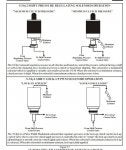Hi I have posted something in the W203 forum, but hoping some of the wizzes here will have an answer, no response on the 203 threads.
W203 2001 Tranny in hard limp, showing this code 2602 and 2600. This means low voltage at both in and out of TCU. But dealer already replaced the TCU and no improvement. Goes into limp after a few km.
Obviously heaps of people are finding the conductor plate are the problem. Dealer thinks its not with these codes. Any thoughts?
Couple of other questions:
- what current max will the TCU draw controlling solenoids. Seems each solenoid may be 2-5A from the ohms in diag info. Can 2 or more work at once? Presumably they only operate for a moment or 3.
Thinking I'll put a lamp or 2 on and drive to see if I have a problem with dodgy connector pin or fuse somewhere glitching voltage.
- someone mentioned an Ultraguage cleared tranny codes, is this the lowest cost unit that may do that? I suspect this will not clear any hard limp, needs an SDS or equiv?
I have the Star classic DVD with schematics and diag suggestions. Car is being repaired by dealer, but they seem stumped and its going to cost a lot of labour, and they've already put in a costly TCU. Drove for a few hours no problem, then tripped hard limp on.
Really keen to see who has fixed this P2602 or has some info that helps !! Is it possible the dealer is seeing a symptom, and the low voltage code is somehow erroneous or irrelevant? Othere modules not showing low volt codes.
I've seen some ESP related weird issues, braking randomly when driving. This feels like speed sensor issues.
Hoping... Greg
W203 2001 Tranny in hard limp, showing this code 2602 and 2600. This means low voltage at both in and out of TCU. But dealer already replaced the TCU and no improvement. Goes into limp after a few km.
Obviously heaps of people are finding the conductor plate are the problem. Dealer thinks its not with these codes. Any thoughts?
Couple of other questions:
- what current max will the TCU draw controlling solenoids. Seems each solenoid may be 2-5A from the ohms in diag info. Can 2 or more work at once? Presumably they only operate for a moment or 3.
Thinking I'll put a lamp or 2 on and drive to see if I have a problem with dodgy connector pin or fuse somewhere glitching voltage.
- someone mentioned an Ultraguage cleared tranny codes, is this the lowest cost unit that may do that? I suspect this will not clear any hard limp, needs an SDS or equiv?
I have the Star classic DVD with schematics and diag suggestions. Car is being repaired by dealer, but they seem stumped and its going to cost a lot of labour, and they've already put in a costly TCU. Drove for a few hours no problem, then tripped hard limp on.
Really keen to see who has fixed this P2602 or has some info that helps !! Is it possible the dealer is seeing a symptom, and the low voltage code is somehow erroneous or irrelevant? Othere modules not showing low volt codes.
I've seen some ESP related weird issues, braking randomly when driving. This feels like speed sensor issues.
Hoping... Greg











